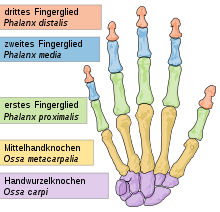index finger
The index finger ( Latin digitus (manus) secundus, index ) is part of the hand . It is the second finger and is located between the thumb and middle finger . He bears his name, as he prefers is used to prevent an object or in a direction to show . A pointer is a hint. The index finger is used most often by all fingers (without grasping). Like the thumb and little finger, it can be moved relatively independently.
anatomy
The index finger is supported by three phalanx bones. Two tendons lead from the index finger to the forearm muscles . The bent finger is extended with the index finger extensor ( extensor indicis ) on the back of the elbow . From the second to the fifth finger, a tendon each leads into a forearm extensor , the long common finger extensor ( extensor digitorum ) . Extensors are stretching muscles of the forearm that act in the wrist. Flexors , on the other hand, are flexing muscles. By the age of twelve months, infants should be able to point at objects with their index finger.
The finger length ratio ( 2D: 4D ) of the index and ring fingers, as a result of the fetal hormone level, is associated with various personality characteristics and disease dispositions .
font
When writing cursive , the index finger guides the pen . In Braille , the characters are felt with the fingertips of the index finger. The right index finger reads one line to the end, while the left index finger is at the beginning of the new line, whereupon the right index finger catches up with the left. The typing on a keyboard is known only to the two index fingers (instead of all ten fingers) also commonly known as a two-finger Eagle search system .
Hand signals and gestures

Index finger alone
- Index finger points to my own chest: me
- Index finger points to the other person or another person: you or he / she
- Index finger points to an object: gestures to draw the attention of the other person / listener to it
- Index finger points in any direction: gesture to indicate that direction
- Outstretched index finger upwards: Attention! Threat (raised or moral index finger)
- Index finger extended upwards swings to the left and right: no ( dudu finger)
- The index finger extended to the front swings up and down: Instruction or threat, you don't do that again!
- Index finger describes a circle on the side of the head: You are crazy!
- Index finger taps the temple or forehead : You are crazy! (show the bird)
- Index finger taps flat on the temple: think about it! (You have to have a head)
- The index finger is stretched out of a fist (directed towards another person) and bent back towards your own body, stretched out again, etc .: Come here!
- The outstretched index finger is placed on the closed lips, pointing upwards: Silence! (pst!)
- Index finger is placed on the alar of the nose: I think about it.
- Index finger taps the nostril: secret symbol (often used in Hollywood films )
- Index finger taps a pad (table): I insist! (now and here)
- Arm stuck up (and index finger): I'll get in touch, I have an idea. In the Roman Empire , this ( digitus salutaris ) was the common greeting gesture .
- An index finger turned into the cheek has different meanings depending on the culture: Italy: Good !, Spain: a reference to homosexuality
- The surgeon's seeing finger. The surgeon felt organ surfaces, tissue properties, changes and limitations of pathological processes (= haptic nosognosia, represented in the cerebral cortex as a tactile stimulus interpretation), which enabled him to make his decisions during an operation as to whether the intervention was feasible, preferably with the - rubber-gloved index finger and to what extent. In connection with long experience, an invaluable important and safe instrument. With the introduction of minimally invasive, pure instrument surgery, a medium that was lost. An important sense organ is to some extent blind.
Index finger with other fingers
- Fist, the upper limbs of the thumb and forefinger rub against each other: sign for money, pay
- The index finger and middle finger are struck against each other in a stretched state: symbol for a pair of scissors (snap snap)
- Index and middle fingers stretched upwards and spread apart in a V : Germany: Victory sign ( victory ); In Great Britain and Australia: (back of hand turned away from others) "Victory" sign, (back of hand to other) meaning similar to the extended middle finger
- Form a ring with your thumb and forefinger: Germany: perfect !; France: null or worthless; USA: asshole ; Southeastern Europe: female genitalia, in connection with an up and down movement: obscene gesture; Japan: Money, or you beg with this gesture. In diving : okay / good / everything is fine!
- Index finger stretched, thumb stretched but bent at the first joint: Pistol (child's play) (Peng Peng)
- Blow over the fingertip of the pistol : I gave it to him!
- Push the nose with the index and middle fingers from below: France: I'll do this with my left hand (with my fingers in my nose)
- In many cultures (e.g. the USA) the pointing finger is used to represent the number one (e.g. when placing an order). In the German culture, however, the thumb is mostly used for this task.
Symbolism of pointing
A reference with the flat of the hand instead of pointing directly at it with the index finger (command tone) to an object or person is considered more polite. The outstretched index finger has been a gesture of power transmission since ancient times. The pointer (from old high German zeigari from zeigôn , to show: Intensivum zu zîhan : to draw, accuse, accuse), formerly also called Salutaris in Latin , transfers its power to what is shown. Today's taboo against pointing fingers at others is said to have its origin in this symbolism. People were afraid that the power of the pointer would be transferred to what was shown, that the pointer would lose its power. It was considered particularly dangerous to point to the sick or suffering, since it was assumed that this gesture would attract the suffering of what was shown. Young children have been tried to induce this gesture by telling them that they are stabbing an angel with it.
Meaning in Islam
In Islam, an outstretched index finger upwards means the unity of Allah ("There is no god but Allah"). The Islamic term for this is Tawheed (تَوْحِيد), the belief in the oneness of God. This gesture has been used for propaganda purposes by supporters of political Islam and by so-called jihadists , especially in recent times . The pointing finger is especially popular among supporters of the so-called Islamic State in Syria and the Levant (ISIS), who use this gesture in photos and videos.
In the Arabic language the index finger is called Musabbiha (مُسَبِّحة). The word is mostly used with the definite article al- (ال) used together: al-Musabbiha (الْمُسَبِّحة). The word al-Sabbāha (السَّبّاحة) is used. The Arabic verbسَبَّحَcomes from the same Arabic word root - sb-ḥ (س-ب-ح) - like the Arabic word for index finger (Musabbiha). The verb means “to praise God”, in which a Muslim “ Subḥāna Allah ” (سُبْحانَ الله) says, which in turn means “Praise be to Allah”.
art
A famous example of showing and transmitting power at the same time is shown in the ceiling fresco " The Creation of Adam " by Michelangelo in the Sistine Chapel . God puts out his index finger and creates Adam. In the fresco itself, the moment after the touch is shown, Adam already lets his own index finger drop. A recent example is a scene of the film E. T. to see.
John the Baptist is usually depicted on Christian sculptures with the pointing finger ( Isenheim Altarpiece ). The function of the Baptist and his finger is to be wise (of wise ) to the greater one who comes.
An upward pointing index finger is considered typical of Leonardo da Vinci's painting style (examples: John the Baptist , The Last Supper ). In the fresco The School of Athens , the Italian painter Raffael embodies the philosopher Plato through Leonardo da Vinci with his index finger pointing upwards.
Aphorisms
- If you point your index finger at other people, you should never forget that three fingers on your hand are pointing at yourself. ( Gustav Heinemann )
- The index finger is a finger that you show when you show something. ( Werner Mitsch )
- In the nose, the raised index finger becomes less important. ( Art van Rheyn )
- The clenched fist is also a clue. ( Rupert Schützenbach )
- When the wise man points to the moon, the idiot only sees the finger. (from China)
Typography and EDP
The symbol of an index finger was also used in the 12th to 18th centuries as a punctuation mark and reference mark on the edge of the text.
The index finger is preferably used to press individual buttons and switches (e.g. light switch, bell button). Because of the symbolism of pressing a button ( mouse click ), many browsers (e.g. Internet Explorer ) display the mouse pointer as a hand with an outstretched index finger when the pointer is over a link .
Unicode
In Unicode there are six symbols that represent a pointing hand:
- black left hand: U + 261A ☚
- black right pointing hand: U + 261B ☛
- white left hand: U + 261C ☜
- white hand pointing upwards: U + 261D ☝
- white right pointing hand: U + 261E ☞
- white hand pointing down: U + 261F ☟
literature
- AA Bailey, P. Hurd, Finger Length Ratio (2D: 4D) Correlates with Physical Aggression in Men but Not in Women, Biological Psychology, Volume 68, Issue 3, March 2005, pp. 215-222.
- Lambert Wiesing: Pointing with fingers and pictures . In: Lambert Wiesing: Let see. The practice of showing . Frankfurt am Main: Suhrkamp 2013. pp. 109–140.
Web links
- Aggressive pointer. On: Wissenschaft.de of March 4, 2005. "Aggressive men betray themselves through their hands."
References and comments
- ↑ What the length of the index and ring finger reveals . Welt Online , September 20, 2011, accessed December 12, 2017
- ↑ S. Lutchmaya, S. Baron-Cohen, P. Raggatt, R. Knickmeyer, JT Manning: 2nd to 4th digit ratios, fetal testosterone and estradiol. In: Early Human Development , 77, 2004, pp. 23-28, doi: 10.1016 / j.earlhumdev.2003.12.002 .
- ↑ Welcome . In: Karl-Wilhelm Weeber : Everyday life in ancient Rome. A lexicon . Artemis & Winkler, Düsseldorf / Zurich 1998, p. 47.
- ↑ Petrus Dasypodius : Dictionarium latinogermanicum et vice versa germanolatinicum ... , Theodosius Rihel, 5th edition Strasbourg 1569, Hh V ("Index: der zeyger, alias Salutaris") and T II ( Zeygerfinger ).
- ^ Friedrich Kluge , Alfred Götze : Etymological dictionary of the German language . 20th edition. Edited by Walther Mitzka . De Gruyter, Berlin / New York 1967; Reprint (“21st unchanged edition”) ibid 1975, ISBN 3-11-005709-3 , p. 877.
- ↑ Philip Verheyn: Anatomy or dissection of the human body […]. Translated from Latin, Leipzig (Thomas Fritschen) 1708; New print Lindau im Bodensee 1981, p. 6 ("[...] is the name of the pointer, meanwhile one uses it in testimony").
- ↑ Arabic الله, starting (from right to left) with the vertical line for A (lif).
- ↑ a b Gerald Drißner: Islam for Nerds - 500 Questions and Answers . createspace, Berlin 2016, ISBN 978-1-5308-6018-0 , p. 521.
- ^ ET, scene on a movie poster
- ↑ The finger of Johannes, Isenheim Altarpiece
- ↑ Pointer






